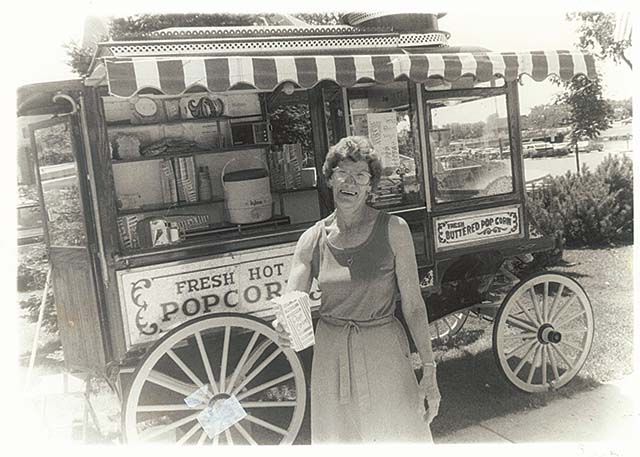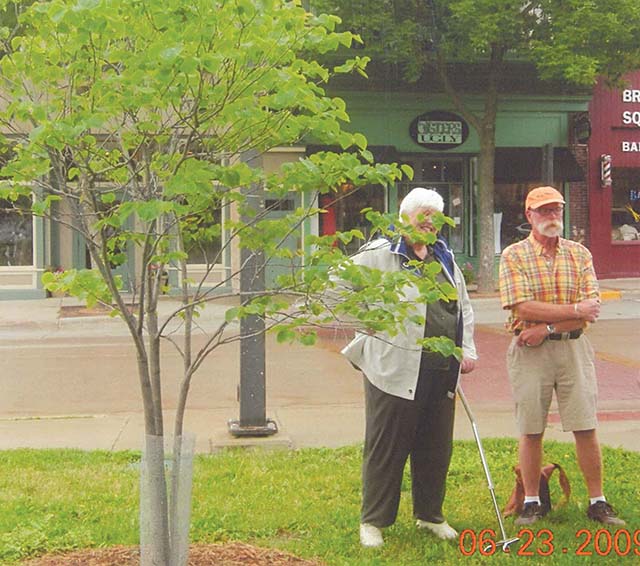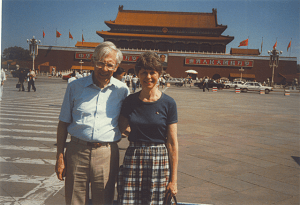
Well, yes, we do have the smell of Malt-O-Meal wafting through our town on a regular basis. But for a “whiff” which says we have survived another Minnesota winter, spring is here and surely summer is just around the corner, nothing beats the first smell of popcorn from the little red and yellow popcorn wagon on Bridge Square. This 1918 wagon has charmed Northfielders and visitors since 1979.
Northfield owes its eternal gratitude for this town icon to a woman named Vera Johansen. While visiting her daughter Sandy in Colorado she had seen a popcorn wagon in Aspen and a dream was born. A June 28, 1979, article in the Northfield News by Scott Richardson described what happened.
“I’d been thinking I’d like to do something like this on my own when I retired,” Johansen (who was then 67) recalled. A “Fix It” column about these wagons in the Minneapolis Tribune led her to Harold Williams of Burnsville. He put her in touch with a friend in Rhinelander, Wis., who was restoring an antique wagon. She decided it would be perfect for Northfield.
Johansen said that the stand was “originally a horse drawn wagon, with steam popcorn equipment.” It was a 1918 wagon made by C. Cretors & Co. of Chicago. The 1979 article continued: “It had not been used in many years when restoration began. With sandblasting and some lively painting, new wheels and new glass, the deteriorating steel hulk was transformed into the vintage masterpiece that graces Bridge Square today.” She purchased it, had it licensed as a business in November of 1978 and the stand opened six days a week to customers clamoring for popcorn in May of 1979. Some quacked for popcorn, too – ducks would come up from the Cannon River to eat kernels spilled around the wagon.
Johansen (born Vera Madsen) was a native of Coulter, Iowa. She graduated from Iowa State Teachers College in Cedar Falls and taught in rural schools. After she married Lewis S. Johansen, they operated a farm until her husband’s death in 1963 brought her to a new life in Northfield. Her daughter Carol was a student at St. Olaf, and Johansen came here to be the head resident of Hoyme Hall for two years. She then worked a couple years at Perman’s clothing store downtown and then about nine years as librarian at the St. Olaf science library before retiring in 1978.

As has happened to those operating the wagon in succeeding years, Johansen was often called upon to answer questions about the town and give directions. She truly enjoyed her customers, she told The Northfield News in 1979, because, “It seems when they come to the popcorn wagon, they’re always in a pleasant mood. So it’s fun.” That first summer volunteers from the Northfield Community Action Center ran the stand each Tuesday and were allowed to keep the proceeds.
Johansen’s daughter Jeanine Landswerk, who now lives in Maple Grove, told me that her mother would get up early in the morning to gather everything together she needed for the day. She would make jugs of lemonade at home which she then poured into paper cups for customers to go along with the popcorn. Working at the stand was a labor of love for her, as she got much pleasure from socializing with people. It was also a family affair. Visiting grandchildren would help her run the wagon and daughters Carol and Jeanine would pitch in as well. In the ’80s she also rented the wagon to her neighbors, the McGee family.
In the fall of 1988 Johansen sold the wagon to Paul Sherwin, who then sold it to his brother and sister-in-law, Wayne and Beth Sherwin of Northfield, a year later.
Wayne Sherwin, who had owned a gas station with Paul at Water and West 2nd streets, threw himself into this new retirement enterprise with alacrity, even buying a fan to push the aroma of fresh popcorn into the square to encourage business. He called this his “advertising budget.” Beth Sherwin told me that her husband wished he had looked into buying the wagon earlier, because he so enjoyed the interaction with people. The stand sold two sizes of popcorn, lemonade, red ropes of licorice and bags of caramel corn. When he died suddenly in March of 1994 at the age of 66, his wife made plans to put the popcorn wagon up for sale.
A newcomer to town, Jim Reiley, talked with Jim Pokorney about possibly purchasing the popcorn wagon. But Bob Jacobsen, long-time proprietor of Jacobsen’s Department Store on Division Street, had other ideas. Reiley first met Jacobsen in Quality Bakery, watching as Jacobsen was extolling the charms of Northfield to a young couple. Jacobsen then invited Reiley to join him at his store and, in the course of their conversation, Reiley talked about the popcorn wagon. Jacobsen said, “No need for you to buy it. That would be a good project for the seniors.” And Jacobsen suggested that Reiley start the fund drive.
“Within half an hour,” Reiley told me, “I was working Division Street, making a pitch for contributions for the seniors to be able to buy the wagon.” Reiley said he got thousands of dollars in firm pledges that day. Jacobsen also had contacted Dorothy Schilling who, with others, helped start the popcorn wagon rolling for seniors, and the popcorn wagon was able to be purchased in May of 1994.

The rest of that year the wagon was repainted, restored and brought up to code by the seniors. The wagon was stored in Schilling’s barn that winter and made its debut on May 18, 1995, with senior citizen volunteers taking on all the chores. (My late father, J.K. Hvistendahl, was among them.) Much of the profits went into a fund for a new Senior Center.
The wagon is so much a part of town life that artist David Allen painted a snowy winter scene of Bridge Square and included the popcorn wagon, even though the wagon always makes its departure long before snow falls.
The wagon is still run by volunteers, who carry on through all kinds of weather and provide continuous cleaning and repairs (including refinishing all the wood surfaces).

Vera Johansen lived to see the popcorn wagon thrive for another 20 years after she sold it. She died at the age of 96 in 2008. Jeanine Landswerk told me that throughout her long life, her mother was “always positive and upbeat, always doing something.” The beloved popcorn wagon of Northfield is now her legacy.
UPDATE: In June 2019 there was a celebration in Bridge Square of the 40th anniversary of the popcorn wagon co-sponsored by FiftyNorth and the Northfield Historical Society. Free popcorn was handed out and the crowd sang “Buttered Popcorn” of the Supremes.
C. Cretors & Co.: Creator of Northfield’s Popcorn Wagon

In 1893 Scientific American noted a unique invention at the Chicago World’s Fair: the world’s first mobile popcorn machine.
“This machine was designed with the idea of moving it about to any location where the operator would be likely to do a good business. The apparatus, which is light and strong, and weighing but 400 or 500 pounds, can be drawn readily by a boy or by a small pony to any picnic ground, fair, political rally, etc. and to many other places where a good business could be done for a day or two.”
This first-ever patented steam-driven popcorn machine, which popped corn in oil was the creation of the Charles Cretors Co. of Chicago, established in 1885. Charles Cretors had started out in a confectionery shop in Decatur, Ill. He soon moved to Chicago where freshly roasted peanuts from a steam-powered peanut roaster that he had improved on quickly became a hit as he peddled them on the sidewalk in front of his shop. By 1893, he had invented a machine which, the www.cretors.com website says, could roast “12 pounds of peanuts, 20 pounds of coffee, pop corn and bake chestnuts as well.”
Also in the 1890s, according to Charlie Cretors, the current CEO of C. Cretors & Co. and great-grandson of the founder, the first horse-drawn wagons were made to sell freshly roasted peanuts, just-popped corn and beverages. An immediate success, the wagons (which came in three variations) were, as the company website says, “for the most part, still nearly custom made, holding to the Cretors tradition – meeting the specific needs of specific customers.”
Bob Pearson’s company, Pearson Creations, in Olathe, Kan., has been collecting, restoring and building replicas of the Cretors popcorn wagons and trucks for more than 40 years. After seeing a picture of the Northfield popcorn wagon, Pearson identified it as a Cretors style model C.
“This horse-drawn model was made as early as 1903 and available through the 1930s,” Pearson told me. The 1918 date ascribed to the Northfield wagon “would be a good guess as to the year of its production,” he said. Pearson estimated that there are fewer than 20 original model C wagons still in use and only 50 or more of model D. The foot shorter C model is considered the “economy” version of the D model and these days Pearson’s company restores and builds more reproductions of model D than C. The extra foot provides room for a sink for cleanup, sometimes required by city codes. (“Otherwise, for the C models, handiwipes will do!” said Pearson.) He estimated the value of Northfield’s popcorn wagon at around $20,000, perhaps more than that due to the historical value of its still being in use. The more original parts a wagon has, the more its value increases, Pearson explained. The Northfield wagon has always run on electricity but did have the trappings of a steam engine when Johansen bought the wagon. The engine is not there today but would be a collectors’ item, selling for $1000-$2000, said Pearson. And if a wagon is gutted out, its worth automatically decreases by at least $10,000. Pearson noted that the Cretors Co. has a “nice C model” (1914) with original equipment on display at its corporate offices in Chicago.
Another feature of the wagons was a small glass tumbler, about six inches long, which had popped popcorn swirling around in it with a small mechanical clown called the “Tosty Rosty Man” making the tumbler turn. This company trademark symbol can be found in advertisements as far back as 1891. Pat Lamb and Ele Hansen, who were in charge of senior volunteers at the wagon for many years, remember that it was part of the Northfield wagon until about the year 2000, when it stopped working. Lamb described the clown as a “marvelous little guy who entertained the kids a lot.” The clown and tumbler “retired” to a shelf in the Senior Center activity room. I called Pearson to ask about its value. He said that even in its current state, it might fetch $500 or more from a collector. The clown by itself could be worth $125-$250. It also could be repainted and made to work again by Pearson Creations. His company also sells replicas of the complete clown/tumbler assembly for $585.
By 1929, electric motors had replaced steam power and smaller versions of the C. Cretors & Co. popcorn machines were gaining great popularity at movie theaters, a popularity which continued through the Depression as movies provided an escape from economic concerns of the times. The company became a government supplier during World War II, not of popcorn machines but of such things as aircraft oil line fittings and mechanical radio components. By the 1950s the company was supplying larger popcorn machines to concession stands in malls, stadiums and drive-ins. In 1998, a G’Zilla popper was introduced with a 240-oz. kettle! Today the company manufactures over 30 models of popcorn machines of different sizes and designs.
Charlie Cretors spoke with me and later e-mailed me about this company which has been in the family for five generations.
“How did we keep it in the family? A quick answer I often give is that we never got real big and we didn’t go out of business,” Cretors said. “The reality is that each generation was very interested in owning and running the company.” His great-grandfather Charles Cretors “was an inventor and businessman” who passed the company to his only heir, a “manager and sales guy” (Hazael DeWitt Cretors or H.D.) who sold what Charles had invented and built. Charlie Cretors’ father (Charles John Cretors or C.J.) had two companies, a sales company and a manufacturing company. Charlie Cretors, with a mechanical engineering degree, took the manufacturing company (Cretors Co.), while his brother Henry (“much more of a salesman than I”) took Iroquois Popcorn, the regional distributor for Cretors.
In 2006, Charlie Cretors became CEO of the company and his son Andrew (who has a business degree and an MBA) was promoted to succeed his father as the fifth president. With Charlie Cretors’ two other children also involved with the company, the company may well carry on the founder’s legacy for many years to come.
We in Northfield are grateful to the Cretors family for making our dearly beloved popcorn wagon possible.








